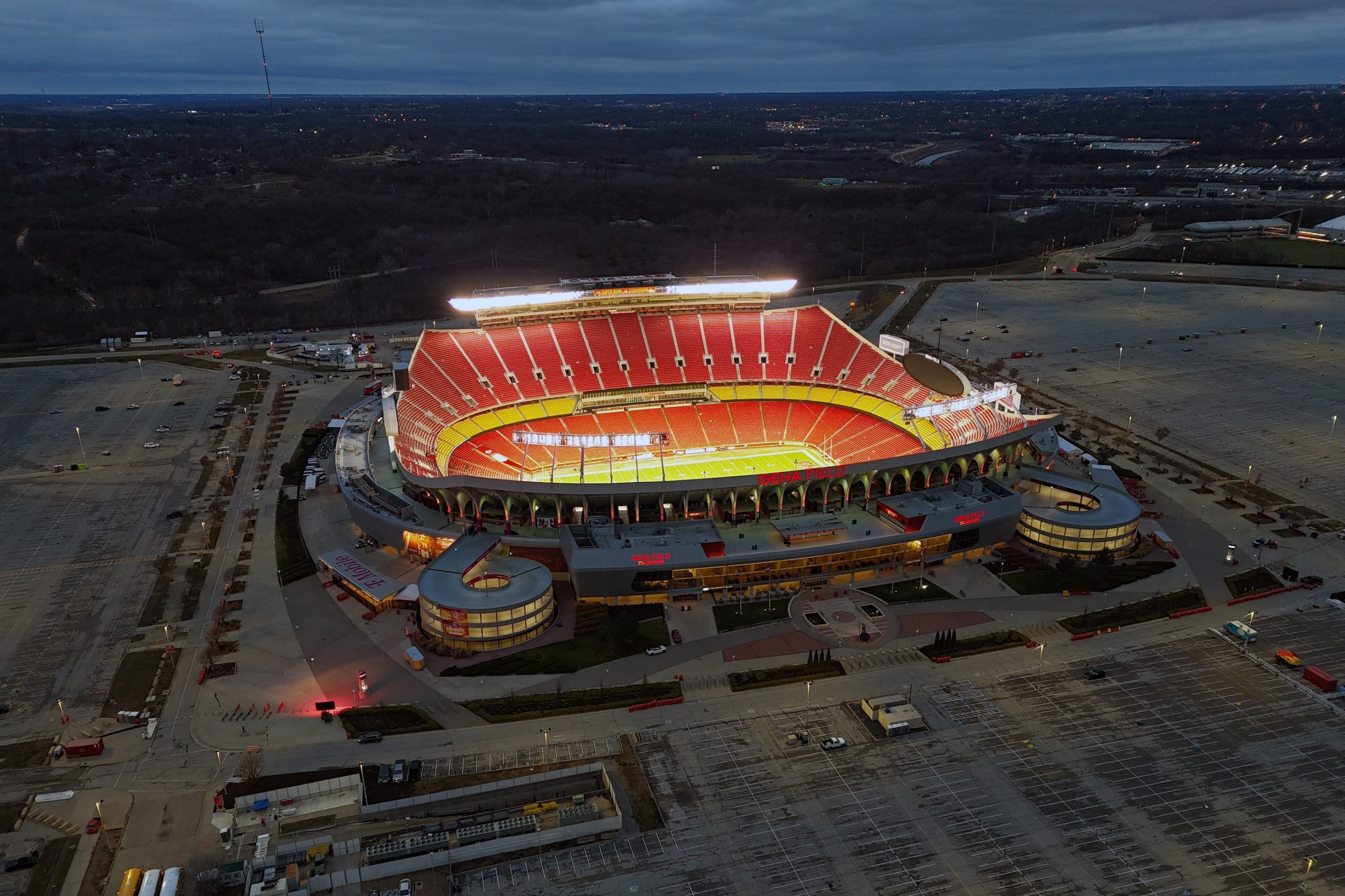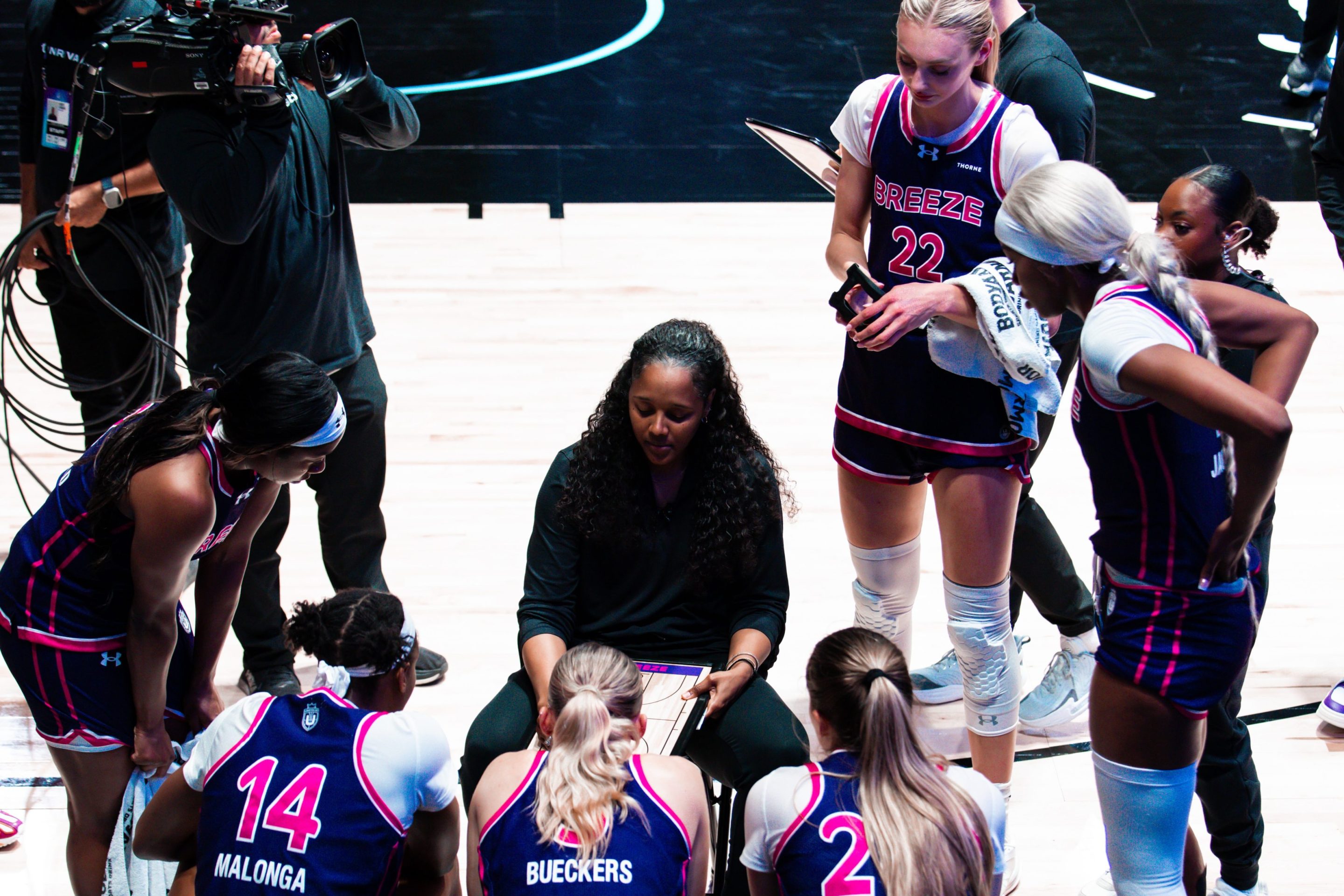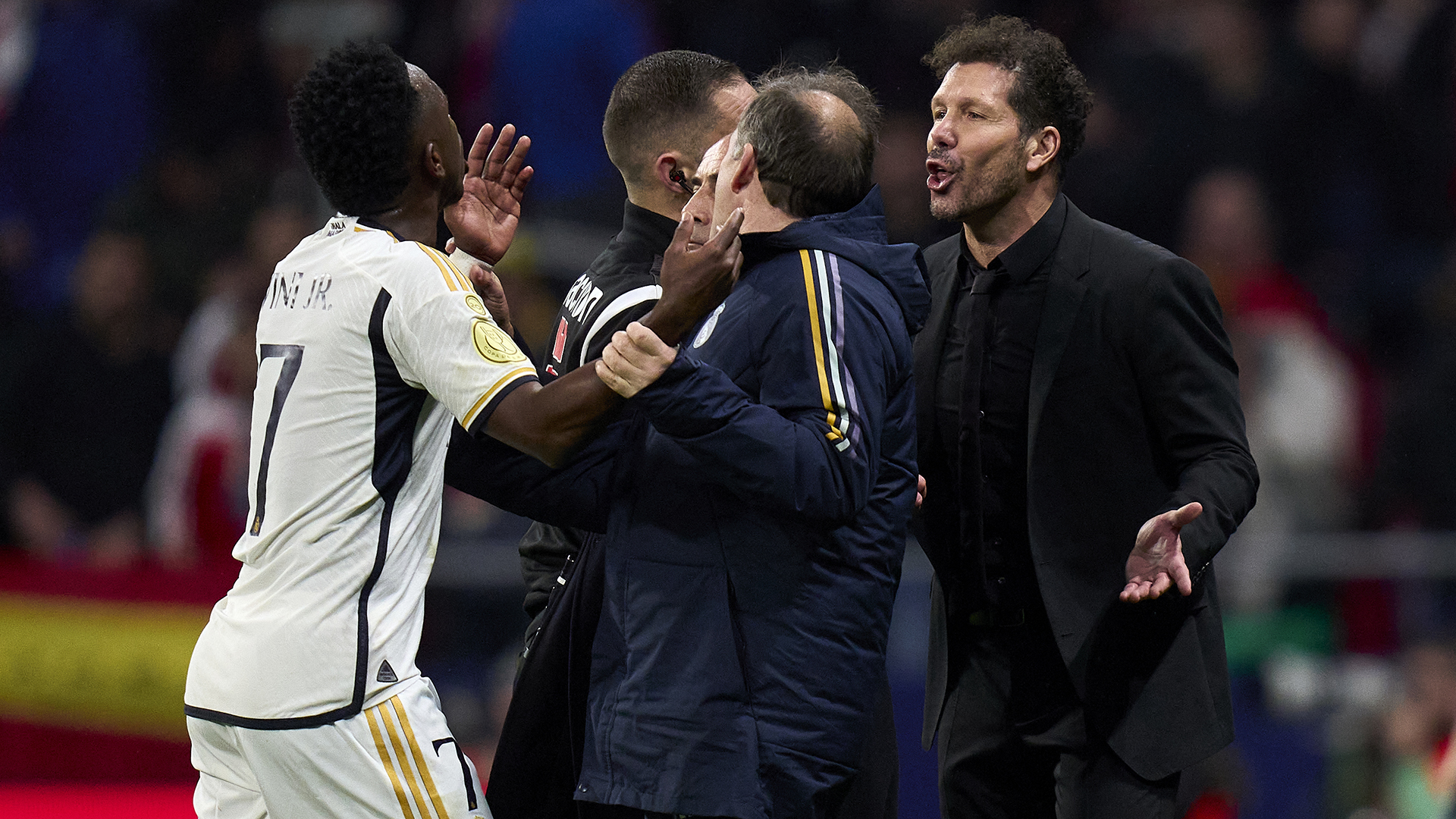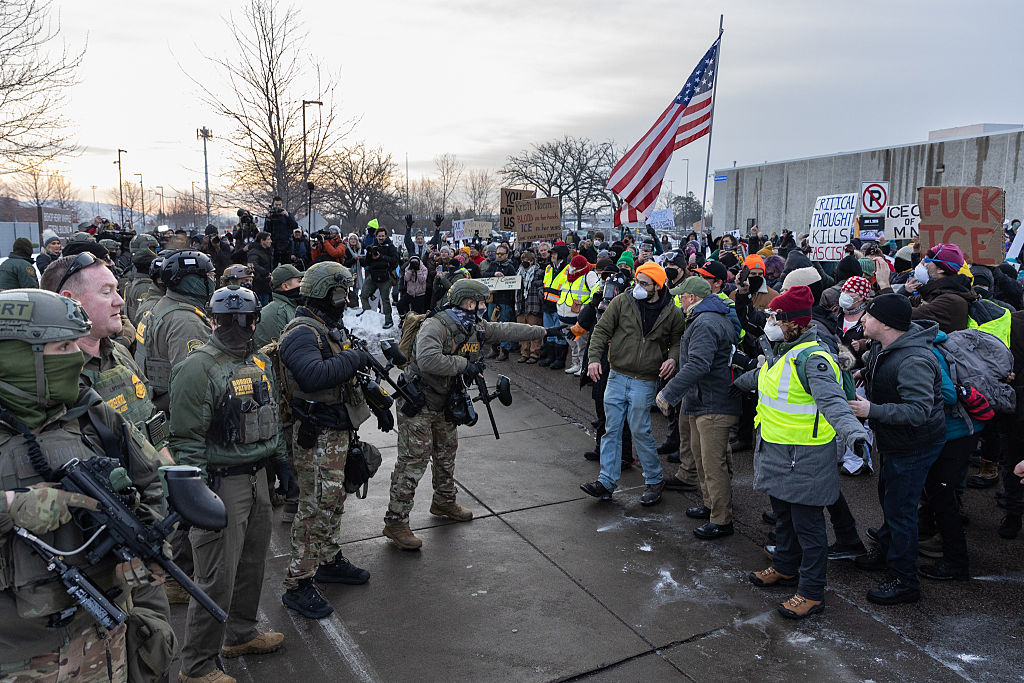The World Cup is coming to the United States—and Canada and Mexico—in just two years, which means soccer fans from all over the world will soon get to experience America’s more and less charming peculiarities. One of those is that, unlike sensible countries, many of our stadiums are either very difficult or impossible to get to by public transit, requiring people to drive there in cars.
There is no dumber way to get tens of thousands of people to and from a single place than having them all come and go in large individual metal boxes. As the transit planner Jarret Walker says, “technology never changes geometry,” and the geometry doesn’t lie. You can fit up to 2,000 people on a train; the same amount of space would fit only a handful of cars. It is easy to get to a stadium if it is in a place people can walk to or reach by train; if a stadium is surrounded by a sea of parking, in contrast, it will take hours to get home. Naturally, the U.S. largely opts for the latter approach.
Back when FIFA used to hold bribing competitions to determine who hosted World Cups, countries would promise to spin up glitzy public transit systems—Qatar’s was built from scratch—if they hosted the competition. But as it became more and more obvious that most of those promises were fraudulent, FIFA no longer asks for that. This is probably for the best. Anyway, the United States made no such promises; as is so often the case with the country’s lacking public infrastructure, it just is what it is.
As a former sports reporter who then became a transportation reporter specifically to complain about how awful U.S. public transportation is, I feel uniquely qualified to pick apart the often pathetic transit options to the 2026 World Cup stadiums. I’ve put together this handy guide for anyone considering attending a game. Hopefully, fans from other countries who expect better can use this guide to plan accordingly, either by avoiding certain cities entirely or choosing to stay somewhere with easy access to and from the stadium. (This, at the risk of a spoiler, will not be anywhere near Miami.)
The best way to get to any sports stadium is walking. It’s convenient, easy, doesn’t depend on anything or anyone else, and if you’re like me you need a good long walk after a game, whether it is out of shame or triumph. Trains are the next best option because they’re fast and fit a lot of people.
I also considered bus and bike options, although those are generally to be avoided. Buses without dedicated bus lanes, which is nearly all buses in the U.S., get stuck in the same traffic as cars. You also need a ton of buses to accommodate a stadium’s crowd, which isn’t all that practical. And with the exception of Levi’s Stadium in the Bay Area, you should only bike to one of these stadiums if you’re curious what the front end of a Ford F-150 feels like.
I’ve grouped the 11 stadiums into tiers of how the non-car options stack up: Actually Pretty Good, Doable But Miserable, and Literally Not Possible. Within those tiers, I ordered the stadiums from best to worst.
Tier 1: Actually Pretty Good
Seattle, Lumen Field (5 Group Stage games including 1 USA match, 1 Round of 32, 1 Round of 16)
Lumen Field is about as good as it gets for a big stadium in the U.S. It’s a reasonable walk from downtown and the central business district which has tons of hotels. The light rail line runs next to the stadium and connects to even far-flung parts of the city as well, including the airport for a quick getaway if that’s your plan. The commuter rail also runs “Sounder Game Trains” from more suburban locations on game days to the nearby King Street train station. But if you’re traveling to Seattle you’ll probably want to stay in the city.
The East Link light rail, which will go from nearby International District out to Bellevue and Redmond, is still under construction but may be open by the World Cup. Given the way every major Seattle transit construction project keeps getting delayed, though, I wouldn’t count on it.
Seattle is a solid biking city by U.S. standards, but it’s not worth the hassle to bike to Lumen Field when walking and the light rail are so convenient.
There are buses, too, but the official website spat me a 404 error when I tried to look up routes while researching this article. It would not be the last time that happened.
Atlanta, Mercedes Benz Stadium (5 Group Stage, 1 Round of 32, 1 Round of 16, 1 Semifinal)
In recent years Atlanta has given Los Angeles a run for its money for the most intensely frustrating traffic in the country. But it deserves credit for building its big new arenas in a dense downtown area with access to the city's transit system. Not only that, but the stadium website takes the extra—and very rare for American stadiums—step of actively encouraging and promoting public transit as the best way to get to the stadium. It is right off the Blue and Green lines.
However, if you’re just going to Atlanta for the game, the easiest move is to stay at one of the many hotels between Centennial Olympic Park and I-85. It is about a mile walk to the stadium through the park.
Houston, NRG Stadium (5 Group Stage, One Round of 32, 1 Round of 16)
Houston is by no means a transit-friendly city, but it has gotten a lot better in recent years in ways that peer cities such as, say, Arlington/Dallas, have not (more on that later). NRG Stadium is served by the Red Line light rail, which runs straight through Midtown and Downtown, where many out-of-town visitors are likely to stay.
With no NRG Stadium experience myself, I asked Cristof Spieler, a lecturer at Rice University, urban planner, and former board member for Houston’s transit system, about getting to and from NRG. He said the Red Line runs every six minutes until 11:30 p.m and the transit system “has gotten really good at stadium crowds—they have lots of staff, nice orderly queues for northbound and southbound passengers, and they'll add in extra trains when the game ends (and sometimes add additional buses as well).” And it can handle crowds, too. According to Spieler, the Red Line carried 114,000 passengers the day of Super Bowl 51. “Every time I’ve ridden for an event it's gone smoothly,” Spieler said.
San Francisco/Santa Clara, Levi’s Stadium (5 Group Stage, 1 Round of 32)
If you’re going to bike to a World Cup game, this is the place to do it. Alone among the World Cup stadiums, the Levi’s official website provides detailed bicycle information, courtesy of Silicon Valley Bike Coalition. According to Eleni Jacobson, community programs manager for SVBC, the partnership emerged thanks to environmental mitigation proposals between the city and the stadium developers. As part of the agreement, SVBC operates two valet bike parking corrals on NFL game days, one by the light rail station and the other just off the San Tomas Aquino Creek Trail which runs adjacent to the stadium. SVBC staff and volunteers monitor the bikes during the event and, as with car valet parking, bring you your bike when you return after the game. On non-NFL event days, only the trail corral is open. Each corral can fit about 200 bikes and 60 scooters, but Jacobson says they usually don’t fill up.
As nice as the valet bike parking sounds, the biggest distinction between Levi’s and all the other World Cup stadiums is that you probably won’t die biking there. The Creek Trail is a 12-mile car-free separated bike path and Jacobson told me it is “the best of all worlds.” It is well-maintained, clear, and has either underpasses avoiding major arterials or dedicated bike traffic signals. Along the route are hotels, cafes, restaurants, shops, and other places people generally like to go.
That being said, if you’re coming from out of town, the biggest issue will be sourcing a bike to ride. Jacobson said there are currently no bike or scooter share services that let you ride to the stadium.
Otherwise, the pickings are pretty slim, here. Walking is mostly out of the question except for a small handful of nearby hotels and neighborhoods. The main transit option is the VTA light rail. That train stops right outside the stadium, but Jacobson, who takes the light rail from downtown San Jose when working bike corral duty, says it otherwise mostly goes through low density suburban neighborhoods and office parks. Still, it’s a convenient option if you stay in downtown San Jose. If you’d prefer to stay in San Francisco, you have to take Caltrain and then transfer to the light rail in Mountain View, which takes about two hours each way. But there’s no guarantee driving will be much better.
Philadelphia, Lincoln Financial Field (5 Group Stage, 1 Round of 16)
Here is a little story that encapsulates Philadelphia’s SEPTA transit system in a nutshell: I learned from the Lincoln Financial Field transportation page there is something called a “Sports Express Service.” I “clicked here” to learn more. The link is dead. So I navigated to the SEPTA website and wound my way through to the “Sports Fanatic” destinations page, which says “The BROAD STREET LINE’S SPORTS EXPRESS service makes it even easier to get from your home to your home field and back again.” I clicked that link. It is also dead. (UPDATE, April 4, 2024: SEPTA emailed us to say they've fixed their website. The relevant information can be found here.)
Philadelphia’s transit service has great bones and should be much better than it is. It might well be, if it wasn’t functionally governed by suburban and state interests that at best don’t give a shit and at worst view it as welfare for the “inner city” and actively want to destroy it.
But it can be done. To get to Lincoln Financial you can take the Broad Street line, which runs up and down Philadelphia’s spine. There will be long lines, but as long as the game ends before midnight the service to and from the stadium at least exists. As an added bonus, the line now uses Tap To Pay, so you don’t have to deal with ticket vending machines or quasi-functioning apps. The fewer dead links to click, the better.
Tier 2: Doable But Miserable
New York/New Jersey, Metlife Stadium (5 Group Stage, 1 Round of 32, 1 Round of 16, Final)
As Barry, David, and Kathryn mentioned here, the World Cup final will be held in a stadium it is illegal to walk to. This is appropriate for a country where pedestrian deaths have reached a 40-year high while other countries are successfully pursuing the goal of zero traffic deaths. We wouldn’t want to give the world the wrong impression.
New York City is home to the most transit-friendly sports destination in the world, but that venue is not Metlife. (People heading to games from New York City will at least get to see that venue, Madison Square Garden, before they descend into Penn Station to take New Jersey Transit.) Taking the train to and from the Meadowlands from either New York City or anywhere in New Jersey requires a connection in Secaucus, which is also appropriate for international visitors. This is a great opportunity for them to experience America’s solution to every transportation problem, which is more cloverleaf highway junctions. Those staying in the city will get another look at American Transit Excellence at Penn Station—not the kinda decent new one which Amtrak serves, but the still shitty old one where New Jersey Transit trains come and go. Every World Cup final ticket should come with photos of the original Penn Station that was torn down in the 1960s. We must bear witness to the crimes of our forefathers.
Boston/Foxboro, Gillette Stadium (5 Group Stage, 1 Round of 32, 1 Quarterfinal)
There is a commuter train that goes to Gillette. During non-game days, it runs every two hours or so. That is, when it runs at all, as MBTA has a penchant for not running trains it is supposed to for no obvious reason. Do not plan on taking this train.
During game days, there is an express train from South Station that you will probably have to buy tickets for days in advance. It’s important to underline that there are not multiple gameday trains in response to demand, as there is in New Jersey. There is a single train that you either make or don’t. It usually arrives in Foxboro more than an hour before kickoff and departs about 30 minutes afterwards. It is extremely possible to miss the train, and be fucked. If you catch it, you should know that it will also be extremely crowded. Be prepared to stand, possibly on the stairs going to the second deck, the entire trip.
I have taken this train before. They say no alcohol is allowed but I can assure you that the determination of Bostonians to drink on the train before and after sporting events far surpasses the wherewithal of the (usually non-existent) MBTA staff to enforce the rules preventing it. I will also note MBTA commuter rail trains have bathrooms that, in practice, basically don’t flush.
The upside of this train is that you won’t have to wait hours in a car to get back to the highway, which you almost certainly will otherwise. South Station is centrally located, with tons of hotels and lots of (unpredictable) transit within walking distance. As in Philadelphia, the bones for a really good transit network are all in place, but the MBTA just sucks ass because it is run by the state of Massachusetts, which regards the MBTA as a patronage mill whose sole purpose is to quarantine Boston from the rest of the state. As a result, it more or less functions that way.
A caveat: all of this, of course, is assuming the gameday train even runs for the World Cup. Which I would sure hope would be the case, but which is not a guarantee, because, see above.
There is also another gameday train that runs from Providence. But to take that you’d have to go to Providence, which I personally do not recommend.
Los Angeles/Inglewood, SoFi Stadium (5 Group Stage including 2 USA, 2 Round of 32, 1 Quarterfinal)
SoFi is a perfect encapsulation of how the U.S. can spend billions of dollars on transportation infrastructure without building anything that’s actually useful. It is near so much, and connected to nothing.
SoFi is part of a massive development that also includes the YouTube theater, a casino, the Kia Forum, and the under construction future home of the Clippers. (You may have heard about its many toilets.) It is between two light rail lines, the K to the north and the C to the south, but not connected to either. The site has been a target for massive development for literally decades, so you’d think improving transit access would have been a priority. You’d be wrong.
For NFL game days, LA Metro runs a free shuttle bus service from the C that actually has solid frequencies of just a few minutes between trips. But, as we learned from the Taylor Swift concert there, it is not remotely adequate for crowds with significant numbers of transit enthusiasts, mostly because of a lack of dedicated lanes on the nearby streets. It’s also not clear if the shuttle buses would run for the World Cup (for example it didn’t run for the LA Bowl). Otherwise, you will have to transfer to local buses from the light rail to get to the stadium.
The only other way to get to the stadium is by car, and that, by all accounts, sucks. And so taxpayers are likely going to spend $2 billion, or 40 percent of what the stadium itself cost, to retroactively do something about that. LA’s proposed solution is to build a “People Mover,” like the ones at many airports, between the K line and the stadium complex. Officials are not even sure that it will be ready for the Olympics in 2028, so you can safely count that out for the World Cup.
This People Mover, if it is built at all, will be in addition to the LAX people mover, which will also connect to the K line, at a cost of $5.5 billion, including what will be the world’s largest car rental facility. It is at this point I must mention LAX is just down the road from SoFi. Like it is barely a dozen blocks from the edge of the airport complex to the stadium complex. Building two People Movers so close to one another is ridiculous. It is even more ridiculous for both of them to connect to the K line, which is either a failing or failed route, depending upon your perspective. This is not me being judgey about LA neighborhoods, either. It is an objective statement based on the K line’s daily ridership of 2,000. Yes, you read that right: two measly freakin’ thousand riders.
This is all such a shame. SoFi’s location was actually not that bad for transit connections, and as transportation reporter and Los Angeles resident Alissa Walker wrote years ago, other proposed locations in Carson and City of Industry were so much worse. There were many possible ways to connect SoFi to the light rail lines, such as a Bus Rapid Transit line, which would have cost merely a few hundred million dollars at most and been done by now. A more ambitious idea could have re-routed the K line from its current failed route to connect the airport and SoFi complex, while further north incorporated that expansion into the proposal to “Finish the Line” by running it into West Hollywood, connecting it with the future extended Purple Line and the B line. That would have been a transformative project for West LA, with a price tag roughly in line with those two people movers. But no. Two people movers connected to a shitty transit line for $7.5 billion it is.
I talked to Walker for half an hour about the SoFi Stadium transit mess, which is much more profound than I could fit in this section. Follow her if you want to stay updated on this mess and how LA is (not) preparing for the Olympics in 2028. But in terms of practical advice for World Cup visitors, Walker suggests staying at an airport hotel and walking along Century Boulevard, which is safe and usually populated with tourists and the like. It’s not the most pleasant walk given the perpetual automobile traffic on that road, but it will take less than an hour to get home after the game. Those taking the walk will almost certainly beat everyone else to their destination. If you get lucky, you can hop on a bus running along Century.
Tier 3: Literally Not Possible
Miami/Miami Gardens, Hard Rock Stadium (4 Group Stage, 1 Round of 32, 1 Quarterfinal, Third Place Game)
There is a bus that goes to Hard Rock Stadium, but no one seems to want you to know that. Google Maps clearly shows bus stops outside the station, but provides no information about what bus it is. The official stadium website does not acknowledge public buses as a form of transportation. The Miami Dade County Metrobus system map does not show the stadium as any kind of landmark. But by using other landmarks, such as the Opa-Locka Executive Airport and NW 199th St, I am pretty sure the bus in question is the 27 and 27A, which during the best of times are scheduled to run every half an hour. I can only conclude from all of this that under no circumstances should you take the 27 bus to Hard Rock Stadium.
It is possible to take a train to the stadium, but it is not public transit, nor is it convenient. The train in question is Brightline, which is owned by a private equity firm called Fortress Investment Group. (Full disclosure: Fortress was a major investor in my former employer, Vice, and purchased it out of bankruptcy while I was employed there.) But that train requires a shuttle, also run by Brightline, to get to and from the stadium; it’s not clear if the shuttle runs for anything other than Dolphins games. If it does run, it departs one hour and 15 minutes before your train leaves. However, the trains are nice and not terribly expensive if booked months in advance.
Kansas City, Arrowhead Stadium (4 Group Stage, 1 Round of 32, 1 Quarterfinal)
Prior to 2008, the local transit authority operated 80 express buses to and from Arrowhead on game days. But that year, a new federal law banned any transit agency receiving federal funds from operating a shuttle service competing with private charter companies. So KCATA shut the express bus service down, and now it costs $50 to park at a Chiefs game because there is no other option.
Technically, you can take the 47 bus from downtown to the stadium. It leaves approximately every 45 minutes to an hour depending on the time of day; the trip to the stadium is scheduled to take an hour. I cannot in good conscience recommend this option, mostly because I cannot find any evidence on the internet of anyone ever having done it.
Arlington/Dallas, AT&T Stadium (5 Group Stage, 2 Round of 32, 1 Round of 16, 1 Semifinal)
The stadium hosting the most World Cup games can only be reached by car.






